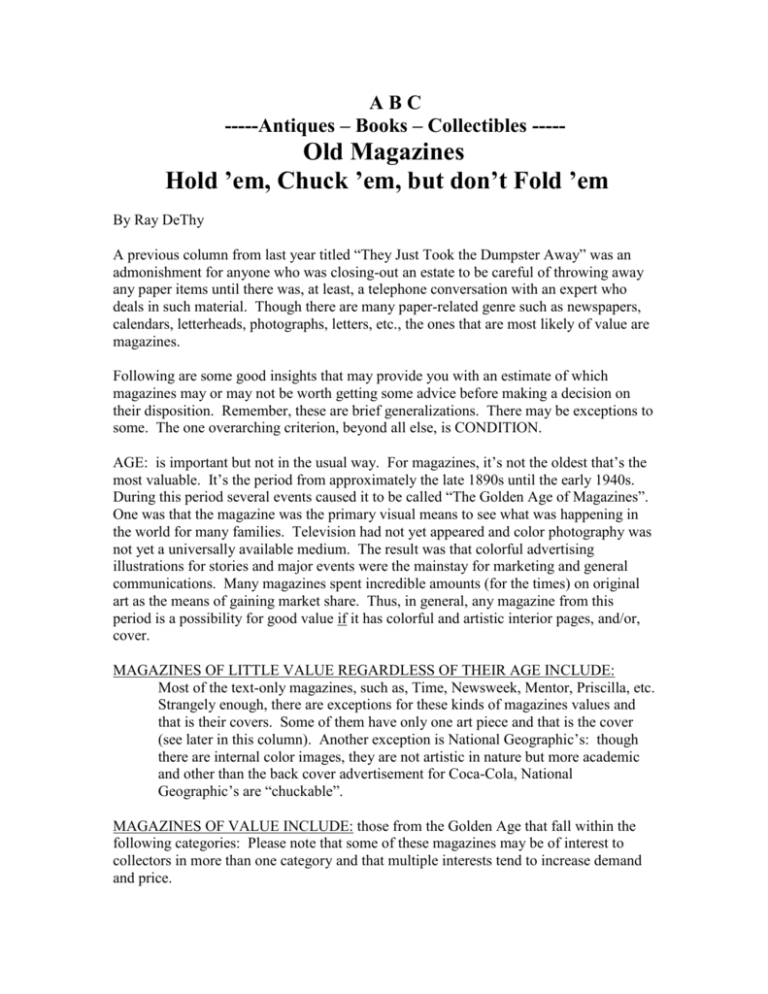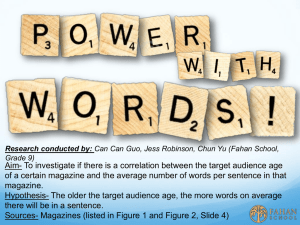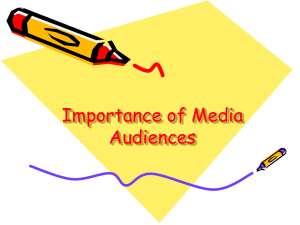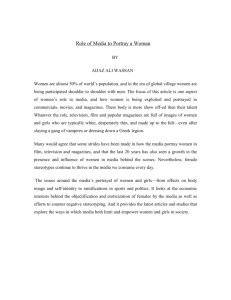Old Magazines - Verde Antiques and Rare Books
advertisement

ABC -----Antiques – Books – Collectibles ----- Old Magazines Hold ’em, Chuck ’em, but don’t Fold ’em By Ray DeThy A previous column from last year titled “They Just Took the Dumpster Away” was an admonishment for anyone who was closing-out an estate to be careful of throwing away any paper items until there was, at least, a telephone conversation with an expert who deals in such material. Though there are many paper-related genre such as newspapers, calendars, letterheads, photographs, letters, etc., the ones that are most likely of value are magazines. Following are some good insights that may provide you with an estimate of which magazines may or may not be worth getting some advice before making a decision on their disposition. Remember, these are brief generalizations. There may be exceptions to some. The one overarching criterion, beyond all else, is CONDITION. AGE: is important but not in the usual way. For magazines, it’s not the oldest that’s the most valuable. It’s the period from approximately the late 1890s until the early 1940s. During this period several events caused it to be called “The Golden Age of Magazines”. One was that the magazine was the primary visual means to see what was happening in the world for many families. Television had not yet appeared and color photography was not yet a universally available medium. The result was that colorful advertising illustrations for stories and major events were the mainstay for marketing and general communications. Many magazines spent incredible amounts (for the times) on original art as the means of gaining market share. Thus, in general, any magazine from this period is a possibility for good value if it has colorful and artistic interior pages, and/or, cover. MAGAZINES OF LITTLE VALUE REGARDLESS OF THEIR AGE INCLUDE: Most of the text-only magazines, such as, Time, Newsweek, Mentor, Priscilla, etc. Strangely enough, there are exceptions for these kinds of magazines values and that is their covers. Some of them have only one art piece and that is the cover (see later in this column). Another exception is National Geographic’s: though there are internal color images, they are not artistic in nature but more academic and other than the back cover advertisement for Coca-Cola, National Geographic’s are “chuckable”. MAGAZINES OF VALUE INCLUDE: those from the Golden Age that fall within the following categories: Please note that some of these magazines may be of interest to collectors in more than one category and that multiple interests tend to increase demand and price. 1. Covers of magazines that are in pristine condition with no defects or attached mailing labels can frequently have a retail value of $3 to as much as $20. or more. Sport and movie stars of the very highest general interest such as Ruth, Mantle, Mays, Marilyn Monroe, John Wayne and other luminaries bring highest values. Artists such as Norman Rockwell, Maxfield Parrish also produced artistic covers that are highly collectible. One irony that relates to magazine cover- collecting is that the most collectible event of any given time-period may not be one that produces high values in the long-term. In fact, such events may make values nearly worthless. Example, John F. Kennedy and related material is of no value today because a high percentage of those living in 1963 bought and saved (in wonderful condition) almost everything printed about J.F.K. – Result? There is far too much available for the few interested secondary market interest of today and if there is an unlikely sale, it may be for less than 50 cents per magazine. Similar situations exist for “Moon landing”, “Nixon’s resignation”, and “WWII” events etc. 2. Complete Magazines’: values are often viewed as collectible to the extent that the cover art/images and/or internal images are collectible. There is little extra value for the complete magazine. 3. Celebrity Images: and related text material is valuable especially if the celebrity is similar to cover criteria noted previously. Color or presentation is not necessary for articles and photographs of Elvis, the Beatles and other similar celebrities. These evoke values in the $2 to $4 range. 4. Tear Sheets: are the pages from magazines that have been removed from the magazine and sold individually to a variety of collectors. These tend to be the most valuable aspects of collectible magazine material. Tear Sheets related to Advertising of Products and Services during the Golden Age Period include ads for: Railroads and Ocean liners; automobiles; food, tobacco, and hygiene products; and jewelry, fashion, cosmetic items. Many of these full page color ads were printed from original art paintings by most of the fine artists of the 40 year period when these were produced. However, fine examples of art nouveau and art deco period designs make tear sheets by unknown or unsigned artists equally valuable. Some examples appear in today’s Values and Tips. Famous Illustrators’ Tear Sheets: because the single most important means that major companies used to further their products and services was to commission the finest illustrator-artists to be their public persona. So important was having a well-known artist/illustrator as a company’s image-maker that there was fierce competition among companies to hire the best available. Maxfield Parrish had exclusive contract commissions to produce ads for Mazda electric Light Bulbs, Colgate-Palmolive products, Community Silverplate Co. and others. Coles Phillips was the image producer for Willys-Jeep Autos. N.C. Wyeth worked with Coca-Cola and others and for 20 years, Norman Rockwell produced covers for the Saturday Evening Post and American Boy (Scout) Magazines. Other less known artists such as Rose O’Neill who did the images for Campbell Soups and her own Kewpie and Loyd LaDriere who produced over 100 full page ads for Cream of Wheat achieved less general fame than the other pre-noted illustrators but his images, none-the-less, bring substantial prices. The average values for full page color ads by the 15 or 20 greatest illustrators are $3 to $40 or more. Condition must be near-mint. In summary, I want to reemphasize the importance of condition. Most collectors who buy magazine material are going to frame and display it so that any small blemish that is visible will make it unacceptable. Ray deThy is the owner of Verde Antiques and Rare Books and Verde Appraisal Service, both in Manahawkin. He has been an appraiser since 1985. VALUE & TIPS VALUES Appropriately, the value and tip for today’s column relates to magazine tear sheets. The five photographs represent a variety of illustrator art for the Golden Age period. Number 1: is a black and white illustration that appeared in the Ladies Home Journal in 1901 (the magazine cost was 5 cents). It was done by the noted children’s art illustrator Jessie Willcox Smith. Value $3-$4. Number 2: is a color 1915 Cream of Wheat illustration by Loyd LaDriere. Its value is $5-$8. Number 3: is a color and metallic print advertisement for a 1935 Cadillac by an unknown designer/artist. Its value is related more to the design and artistic printing process than to the imagery. Its value is $7-$8. Number 4: is a 1920 Ladies Home Journal advertisement for Willys-Jeep auto by Coles Phillips. Its value is $8-$12. Number 5: is a Community Silverplate advertisement by Maxfield Parrish that appeared in the Ladies Home Journal in 1918. Its value is $10-$20. TIP It is obvious from the items selected for today’s values section that all ads are not created equal. Some artists and especially, Maxfield Parrish, can bring prices as high as $100. for a single magazine tear sheet. The reason for very high prices for items that may have been originally produced for as little as a penny or two is that these tear sheets are, in effect, original prints. That is, even though were reproductions of original art at the time, the rationale for calling them ORIGINAL is that they were first printings of the particular image. The proof for that first printing is the date of the magazine. The irony is that, using Maxfield Parrish as an example, one can buy a high quality current reproduction of one of his earlier works for as little as $2 or $3. The difference between that minimal sum and what may appear as an obscene value for the tear sheet is the rarity of each. There are perhaps thousands of the current reproduction available as opposed to a hundred or less of the original tear sheets that have survived until today in frameable and displayable condition. Rarity costs!





